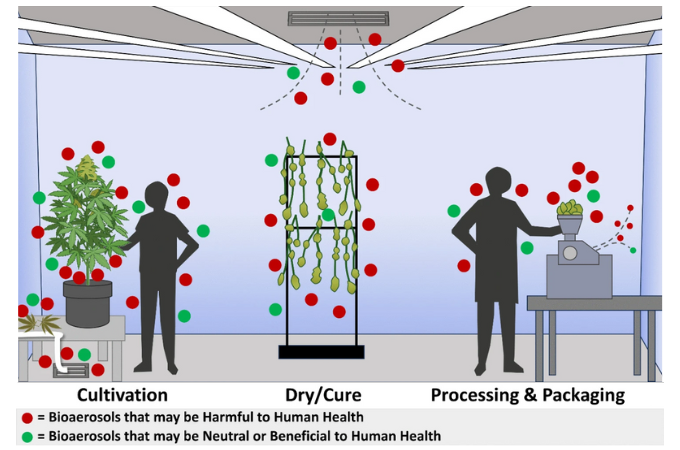Tess Edim, Tara Nordgren, and Mark Hernandez recently published a paper on bioaerosols in cannabis environments, offering actionable steps to reduce risks and ensure a safer workplace. Here are key takeaways to guide workers, operators, and safety professionals.
What Are Bioaerosols?
Bioaerosols are airborne particles that originate from biological sources. These can include fungal spores, bacteria, viruses, and fragments of plant material. In cannabis cultivation and manufacturing, bioaerosols are particularly prevalent due to the high levels of organic matter and humidity. Workers are especially at risk, as they are constantly exposed to these particles during activities like, but not excluded to, trimming, harvesting, and processing. According to the study, Inhaling these particles can lead to respiratory issues such as occupational asthma, bronchitis, and other pulmonary diseases. Understanding what bioaerosols are is the first step in recognizing the importance of mitigating their impact in the workplace, and ensuring the end product is free from contaminants that could become a risk to public health.
Bioaerosols in Cannabis Workplaces
Bioaerosols are a significant concern in cannabis workplaces due to the nature of the industry. Indoor cultivation facilities often have high humidity and organic materials, which create an ideal environment for the growth of fungi, bacteria, and other microorganisms. These bioaerosols become airborne during routine tasks such as trimming, drying, and packaging cannabis products.
“The density of airborne fungal spores in cannabis facilities is notably higher compared to other agricultural environments,” which is a huge risk operators need to act on to prevent further losses in slumped markets. Workers are at risk of inhaling these particles, leading to respiratory conditions like hypersensitivity pneumonitis and chronic bronchitis. In addition, the presence of pollen and other plant materials can exacerbate allergies, making it difficult for employees to work effectively.
Health Risks for Cannabis Workers
A notable concern is occupational asthma, which can cause wheezing, shortness of breath, and chest tightness. Another serious condition, mentioned above, is hypersensitivity pneumonitis, an allergic reaction that can cause inflammation in the lungs, leading to symptoms like cough, fever, and fatigue.
“Workers in cannabis facilities are at higher risk for chronic respiratory diseases due to prolonged exposure to bioaerosols.”
Long-term exposure can also result in chronic bronchitis, characterized by persistent cough and mucus production. Additionally, allergens in the workplace can trigger severe allergic reactions, further compromising worker health. Understanding these health risks is essential for developing strategies to protect the workforce and ensure a safe working environment.
Mitigating Bioaerosol Risks: Effective Ventilation Systems
Implementing effective ventilation systems is crucial for mitigating the risks posed by bioaerosols in cannabis workplaces. Proper ventilation helps to reduce the concentration of airborne particles, including that which was found in higher concentrations within cannabis facilities (hazardous fungal spores, bacteria, and plant material). Advanced HVAC systems equipped with HEPA filters can capture a significant portion of these bioaerosols, thereby improving air quality within the facility. According to the study, “Effective ventilation systems can decrease airborne contaminants by up to 80%,” making it an essential component of a safe working environment. Thats a massive risk reduction, and insurance companies should take note when dealing with high-risk current and potential clients.
Additionally, ensuring adequate airflow prevents the buildup of humidity, which can exacerbate the growth of mold and other microorganisms. Regular maintenance and monitoring of these systems are also vital to ensure they function optimally! Investing in robust ventilation solutions not only protects worker health but also enhances overall productivity by providing a safer and more comfortable environment, and lessens the risk of contamination and product loss.
Personal Protective Equipment (PPE)
PPE such as masks, gloves, and protective clothing creates a barrier between workers and harmful airborne particles. High-efficiency particulate air (HEPA) masks are particularly effective, as they can filter out up to 99.97% of airborne particles, including fungal spores and bacteria. “Wearing appropriate PPE can significantly reduce the risk of respiratory issues among cannabis workers.” In addition to masks, gloves help prevent skin contact with plant materials that may cause allergic reactions.
Protective clothing, such as coveralls, further minimizes the risk of contamination and the spread of bioaerosols. Training employees on the proper use and maintenance of PPE is crucial for ensuring its effectiveness! By incorporating quality PPE into daily operations, cannabis businesses can create a safer work environment and protect their workforce from potential health hazards.
Regular Health Monitoring
Regular health monitoring is a critical strategy for mitigating bioaerosol risks in cannabis workplaces. In other industries, Occupational Surveillance is required and reports made public, yet this is not the case for cannabis. Washington State is the only state with a mandatory occupational surveillance program, placing the responsibility on operators to do right and take active measures to keep their staff and the public safe.
Regular and consistent health check-ups can help detect early signs of respiratory, dermal (skin), and ocular (eye) issues, enabling timely intervention and treatment. “Early detection of respiratory conditions can significantly improve long-term health outcomes for cannabis workers.” Health monitoring should include lung function tests, allergy screenings, and regular health assessments to identify symptoms such as coughing, wheezing, or shortness of breath.
Keeping detailed health records allows employers to track trends and address potential hazards promptly. Additionally, workers should be encouraged to report any respiratory issues immediately, ensuring they receive the necessary medical attention. Implementing a comprehensive health monitoring program not only protects the well-being of employees but also contributes to a safer and more productive work environment by addressing health concerns before they escalate into very costly problems.
Why Immediate Action is Crucial
Delaying the implementation of safety measures can lead to severe health consequences, including chronic respiratory conditions, decreased overall workforce productivity, insurance problems, and a litany of other issues that will be unproductively costly to operators. As research highlights, “The longer workers are exposed to bioaerosols, the higher their risk of developing serious respiratory diseases.” Additionally, addressing bioaerosol hazards promptly can help businesses avoid potential legal liabilities and regulatory penalties.
Implementing effective ventilation systems, providing personal protective equipment, and conducting regular health monitoring are essential steps that should not be postponed. Acting now not only ensures compliance with health and safety standards but also demonstrates a commitment to employee well-being and respect for the community. In the rapidly growing cannabis industry, prioritizing worker safety should not just become a regulatory requirement, but a moral imperative for operators
Further Reading and Resources
For those looking to delve deeper into the topic of bioaerosol hazards and mitigation strategies in cannabis workplaces, several resources are available. The CDC and OSHA provide comprehensive guidelines on managing bioaerosol risks in various industries, including cannabis. Additionally, the National Institute for Occupational Safety and Health (NIOSH) offers research and recommendations specifically tailored to agricultural and manufacturing environments. There are several Health Hazard Evaulations (HHE) that showcase where problems occur within facilities in order for the operators architects and industrial hygenists to better understand how to mitigate health risks. For further reading, check out the full study here.
Header graphic credit: Tess Eidem, Tara Nordgren & Mark Hernandez





